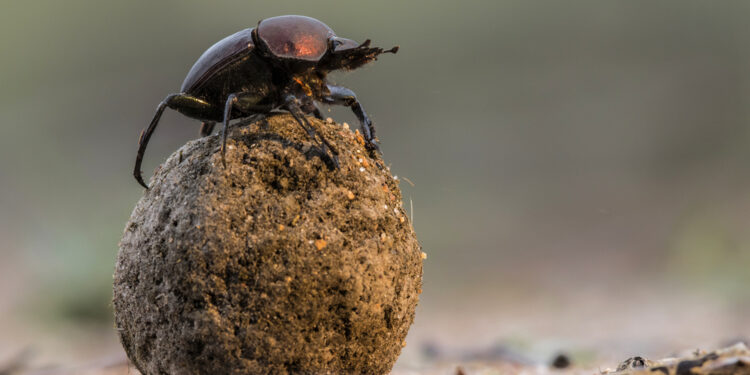In the vast expanses of the natural world, one small creature has forged an extraordinary connection with the cosmos. The humble dung beetle, often overlooked for its unglamorous lifestyle, uses a form of celestial navigation unseen in any other insect species. Their method of orienteering is quite literally out of this world. This tiny creature utilizes the Milky Way’s shimmering belt of stars to navigate, showcasing an astonishingly sophisticated biological adaptation.
The dung beetle is a resourceful insect, renowned for its unique role in the ecosystem. They recycle waste, primarily dung, and turn it into nutrient-rich soil. This process is not only vital for the survival of the beetles themselves, who lay their eggs in these dung balls, but also for maintaining the health and fertility of the landscapes they inhabit.
Their remarkable behavior is not limited to their waste management practices. These beetles demonstrate extraordinary navigational abilities that are nothing short of cosmic. This intriguing trait was initially discovered by a team of Swedish and South African researchers in 2013. While it had been known that some animals use stars for orientation – such as migratory birds and sea turtles – the concept that an insect could do the same was unprecedented.
These researchers observed that the beetles, especially the species Scarabaeus satyrus, moved in remarkably straight lines, despite their terrain being devoid of notable landmarks. They hypothesized that these insects must be using some form of celestial guidance. This assumption was later confirmed through a series of ingenious experiments, where beetles were observed under varying sky conditions.
When the sky was clear and the Milky Way was visible, the beetles navigated efficiently in straight lines, rolling their dung balls away from the pile, which minimized the risk of theft from other beetles. However, under overcast conditions, or when the Milky Way was artificially obscured, their paths became disoriented and circuitous.
Researchers further tested this hypothesis by placing tiny hats on the beetles, effectively blocking their view of the sky. These beetles, too, lost their sense of direction, further reinforcing the conclusion that dung beetles navigate using celestial cues. These tiny creatures, it seems, have a built-in star map.
But how does an insect with such small eyes perceive the Milky Way, let alone use it for navigation? The answer lies in the beetle’s extraordinary vision. Dung beetles are known to have one of the best night visions in the insect world. Their compound eyes can capture light effectively, even in low-light conditions, allowing them to perceive the bright strip of light that is the Milky Way.
Interestingly, the beetles don’t need to recognize individual stars. Instead, they use the gradient of light provided by the Milky Way. This gradient, along with their excellent peripheral vision, allows them to maintain a straight path and navigate effectively in the dark.
This fascinating discovery of the dung beetle’s galactic guidance system not only provides insights into the vast capabilities of insect navigation, but it also opens the door to more profound questions about the relationship between life on earth and the cosmos. It further blurs the line between the terrestrial and the celestial, highlighting that even the smallest creatures on our planet are inextricably linked to the vast expanse of the universe.
By using the starlight of the Milky Way for navigation, dung beetles offer a humbling reminder of nature’s ingenious adaptations. These tiny architects of the soil show us that the connection between the earth and the cosmos is not just the stuff of poetry and philosophy, but a tangible, navigational reality.
The humble dung beetle, in its extraordinary way, challenges our understanding of nature, navigation, and the universe. It’s a shining example of how life on earth is intertwined with the cosmos in the most intricate and fascinating ways. It forces us to re-evaluate the complexity of life’s adaptations and marvel at the unassuming creatures that carry the map of the galaxy in their biological compass. This connection, as evident in the dung beetle, underscores the essential unity and interconnectedness of all life, from the microscopic to the cosmic scale. It serves as a reminder that we are all part of a grand cosmic ballet, dictated by the stars and spun across the canvas of the universe.
These beetles, while small and often overlooked, are mighty navigators with an extraordinary ability that provides them an important survival advantage. It is a testament to the remarkable diversity and complexity of life on our planet, and our continuing journey of discovery and understanding. As we learn more about these creatures and their celestial navigation, we too can reflect on our place in the universe and how we navigate our own lives, guided by our unique stars.
The dung beetle, with its celestial compass, truly embodies the marvel of natural evolution and the profound connections between life and the cosmos. It invites us to look up at the night sky with renewed wonder, knowing that even in the smallest of creatures, the universe finds a way to guide and connect.






